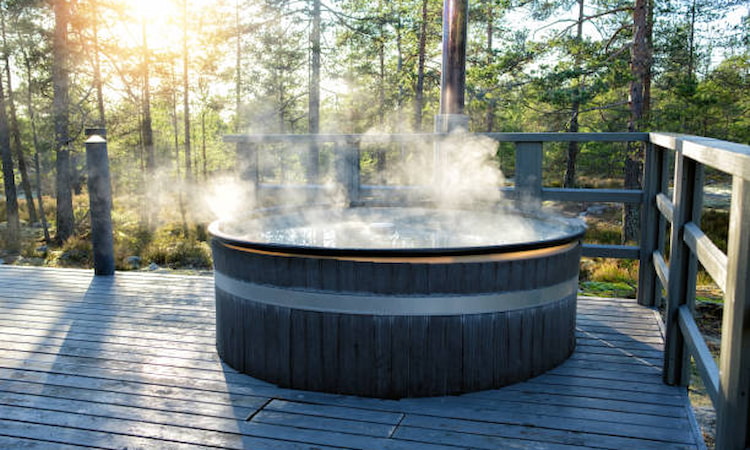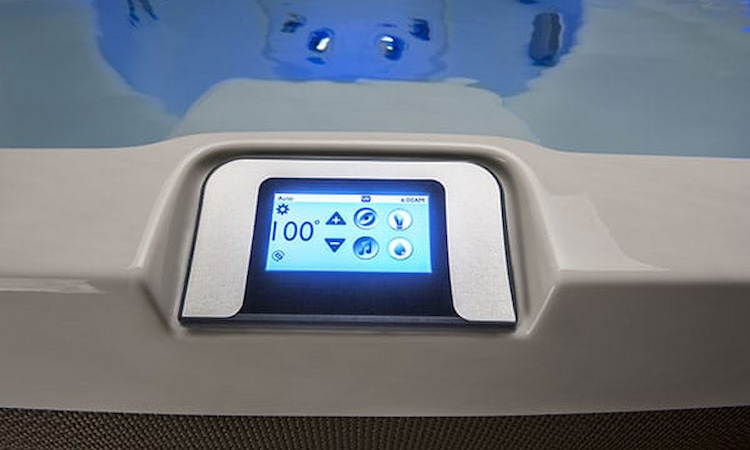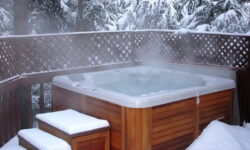You’re ready to sink into your hot tub, but is 107 degrees too hot? It’s essential to know the right temperature for your safety and enjoyment. Overheating can lead to serious health risks, so understanding the science behind hot tub temperatures is crucial.
Yes, 107 degrees is too hot for a hot tub. The recommended safe temperature for a hot tub is up to 104 degrees Fahrenheit. Above this, there is a risk of overheating, leading to dizziness, fainting, or even heat stroke. Therefore, keeping a hot tub at 107 degrees could be dangerous for your health.
Let’s find out how to safely monitor your hot tub’s temperature and determine your perfect heat level for a personalized, safe, and relaxing hot tub experience.

Quick Navigation
Understanding the Ideal Hot Tub Temperature
You’ve got to know that the ideal hot tub temperature typically falls between 100 and 102 degrees Fahrenheit. Now, you might be wondering, why this range? Well, it’s essential to maintain a balance between comfort and safety. While soaking in warm water can be a wonderful way to relax, it’s critical not to overdo it.
Too much heat can lead to overheating and dehydration, especially if you’re spending a considerable amount of time in the tub. A temperature of 107 degrees is too hot. It’s not just uncomfortable; it can pose a real risk to your health. Remember, hot tubs aren’t just about warmth; they’re about relaxation and therapy, so it’s important to keep the temperature in the safe zone.
Also, if there are children or older adults using the tub, you need to be even more cautious. Their bodies may be more sensitive to high temperatures. As a rule of thumb, always start at a lower temperature and gradually increase if necessary.
But remember, don’t ever go above 104 degrees, as it can be harmful. Always prioritize safety over warmth when using a hot tub.
Health Risks Associated With Overheating in a Hot Tub
Basking in a too-hot tub might seem like a great way to unwind, but it’s important for you to know the health risks associated with overheating, which include dehydration and heat exhaustion. When you’re soaking in water above 104 degrees Fahrenheit, your body can’t regulate its internal temperature effectively. This can lead to a rapid loss of fluids, causing dehydration. You’ll feel dizzy, have a dry mouth, and could even faint.
Heat exhaustion is another risk. As your heart races to cool your body, you may start to feel nauseous, have a headache, or experience a rapid heartbeat. If not addressed immediately, this can progress to heat stroke, a serious condition that can lead to loss of consciousness or even death.
Don’t forget about the risk of burns. Prolonged exposure to hot water can cause first to third-degree burns, especially in sensitive areas. The best way to avoid these dangers is to keep your hot tub at a safe temperature, ideally between 100-102 degrees Fahrenheit, and limit your soak time to 15-20 minutes. Remember, safety first when it comes to hot tub use!
The Science Behind Hot Tub Temperatures

During the time you’re soaking in a hot tub, your body is conducting a complex dance of temperature regulation, and understanding the science behind this can help you set the right hot tub temperature for maximum safety and enjoyment.
It’s all about maintaining your body’s core temperature. If the water is too hot, you risk overheating; too cold, your body must work to stay warm. Let’s delve into the science:
Your body responds to hot tub immersion:
- Vasodilation: Blood vessels near your skin expand to release heat.
- Sweating: As a cooling mechanism, your body sweats, but in a hot tub, this doesn’t effectively cool you down as the sweat doesn’t evaporate.
Ideal hot tub temperatures:
- 100-102°F: This is typically the most comfortable range.
- 104°F: This is the maximum safe limit set by the Consumer Product Safety Commission.
How to Safely Monitor Your Hot Tub Temperature
In the quest for both comfort and safety, you’ll need to consistently monitor the temperature of your hot tub, and here’s how. It’s important not to let the water temperature exceed 104°F, as it can lead to hyperthermia, a dangerous condition where the body absorbs more heat than it can dissipate.
To help you monitor the temperature, here’s a simple table outlining three key steps:
| Steps | Description | Frequency |
|---|---|---|
| 1. Use a reliable thermometer | Don’t trust built-in thermometers; always double-check with a handheld one. | Each time before use |
| 2. Regularly calibrate your thermometer | This ensures it gives accurate readings. | Monthly |
| 3. Keep a log | Document the temperature each time you use the hot tub to spot any irregularities. | Every use |
Personalizing Your Hot Tub Experience: Finding Your Perfect Temperature
While safety is crucial, you shouldn’t overlook personal comfort, and finding the perfect hot tub temperature for you can make a world of difference. It’s not just about following the standard recommendations, every individual has unique preferences.
Here’s how you can personalize your hot tub experience:
- Experiment with temperatures: start at the recommended 100-102°F and adjust in small increments. Be sure to give your body time to adjust before deciding if it is comfortable.
- Consider health factors: if you’ve got medical conditions like heart problems or high blood pressure, consult with your doctor before setting your hot tub temperature. Pregnant women should keep the temperature below 100°F.
Frequently Asked Questions
Hot tubs are typically made from durable materials like acrylic, fiberglass, or thermoplastic, which can withstand high temperatures. You’d find insulation materials within the tub’s shell to maintain those intense degrees of heat.
High temperatures in your hot tub can increase evaporation rates, wasting water and energy. It also stresses your system’s components, leading to possible premature wear and tear. It’s not eco-friendly or cost-effective.
Extended use of a hot tub at very high temperatures can lead to dehydration, low blood pressure, and in severe cases, unconsciousness. It’s important to limit your time in the hot tub and stay hydrated.
Yes, there are alternatives. You could use solar power or wood-fired heaters. Solar is eco-friendly, while wood-fired gives an authentic experience. But always monitor temperatures for safety. Overheating can cause burns or heat stroke.
Conclusion
In conclusion, yes, 107°F is too hot for a hot tub. Always prioritize safety and avoid health risks associated with overheating. Understand the science behind hot tub temperatures, monitor them accurately, and adjust accordingly.
Remember, everyone’s comfort level varies. Find your perfect temperature that promotes relaxation and wellness. Keep in mind, safe hot tubbing is smart hot tubbing.






